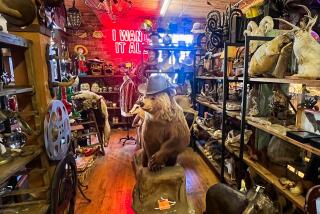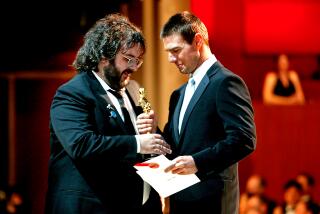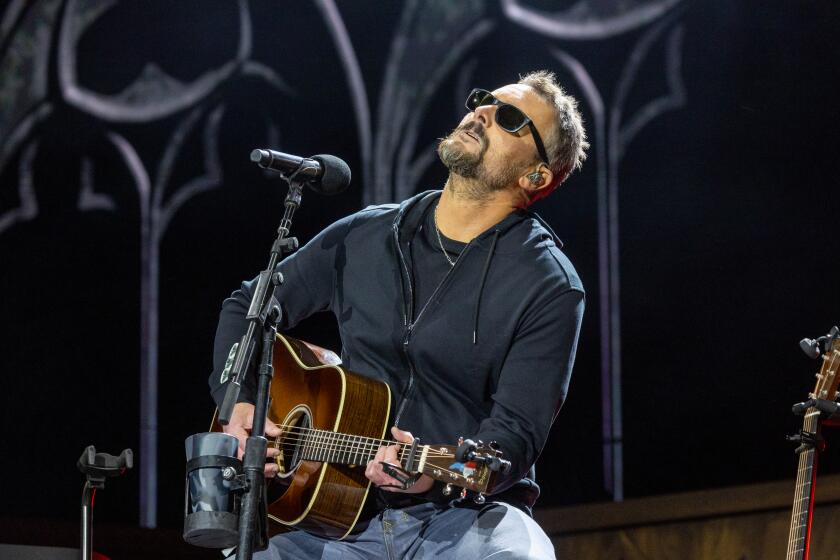‘The Hobbit’ will usher in a new technology at movie theaters

Wendy Aylsworth fixed her eyes on a screen at the Landmark theater in West Los Angeles, carefully studying a scene of hobbits preparing a lavish feast.
“We’re seeing good detail and a richness in the characters,” Aylsworth said. “It’s right on.”
The Warner Bros. senior vice president of technology was reviewing a test reel for the “The Hobbit: An Unexpected Journey,” and a new projection technique that will show the highly anticipated Peter Jackson movie at 48 frames a second.
The controversial new technology could revolutionize traditional movies, which have been projected at a standard 24 frames per second for almost 90 years. Warner Bros. will become the first studio to release a major Hollywood movie in 48 frames a second when its “Hobbit” premieres in the U.S. on Dec. 14.
VIDEO: Peter Jackson on ‘The Hobbit’ and 48 frames format
The studio has been running the test reel in hundreds of theaters from Los Angeles to Tokyo to Madrid to ensure that the theaters are ready for the rollout of the new technology.
Warner is also hedging its bet: The high-frame-rate version of “The Hobbit” will be shown on only about 450 screens of an estimated 4,000 screens in the U.S. and Canada that will show the movie.
“When you have something new, you want to make sure it works,” said Dan Fellman, president of domestic distribution for Warner. “This is unique, it’s different and we’ll have to see how people adjust to it.”
Industry reaction in advance has been a mix of apprehension and excitement.
“We had some theater owners that were disappointed they didn’t get more runs,” John Fithian, president of the National Assn. of Theatre Owners. “The difference is obvious and dramatic. The question is whether or not it’s a difference that drives patrons to the theater.”
Jackson and director James Cameron — who plans to release upcoming “Avatar” sequels at the even higher rate of 60 frames a second — have no doubt that it will. They contend that seeing more images each second is more natural because it’s closer to what the human eye actually sees, giving a sharper, more lifelike picture and reducing eyestrain for 3-D movies.
VIDEO: Radagast and a new trailer for ‘The Hobbit: An Unexpected Journey’
“Now, in the digital age, there’s no reason whatsoever to stick to 24” frames a second, Jackson writes in a Q&A; posted on his Facebook page.
Proponents of the higher frame rate say it packs the screen with far more visual information and makes the moving image super-sharp and detailed. But patrons accustomed to the softer look of traditional film may have to adjust to the higher frame rate.
At a 10-minute preview that Jackson shared at the trade show CinemaCon in April, some attendees found the images jarringly hyper-realistic and too unlike a traditional film.
Warner executives said that was unfair because it was rough footage that had not been color corrected.
“It really wasn’t representative of what it looks like today,” Fellman said. “I think it will have a big impact on the industry.”
Some leading theater executives agree. They view faster frame rates — along with big screens, 3-D and improved sound systems — as a way to stay relevant to younger audiences who are increasingly lured away by entertainment options in the home. Although box-office revenues are expected to reach a record this year, largely because of a crop of hit movies and higher ticket prices, movie attendance levels have been trending lower most of the last decade.
PHOTOS: Hollywood backlot moments
“We’re always excited when there is a new technology for our business that widens the gap between what happens in the home and what happens in the theater,” said Amy Miles, chief executive of Regal Entertainment Group, the nation’s largest theater chain.
Regal will show “The Hobbit” at 48 frames a second on more than 100 of its 6,607 screens. Advance ticket sales suggest that many of those theaters are generating more revenue per screen than regular 3-D theaters, Miles said.
“I’m a big believer in it,” said Tim Warner, chief executive of Cinemark USA Inc., which is screening “The Hobbit” in 48 frames a second on 160 of its 5,207 screens worldwide. “This is a much more immersive, sharp and engaging experience. It feels like you’re right there.”
In fact, Warner said, Cinemark was hoping to add more theaters. “I would have preferred to have gone wider, but Warner is trying to feel their way on it, which I can understand.”
“Hobbit” will be shown in old-fashioned 2-D, in traditional 3-D and in 3-D at 48 frames a second. For now, theaters will not be charging extra for the higher-frame-rate screenings, which will be included in the higher-priced 3-D tickets.
The cost of bringing high-frame-rate viewing to most theaters is $1,000 to $2,500 per screen. Cinemas that already have the newest digital projectors typically require only a software upgrade or a new video card.
Still, many cinema chains are adopting a wait-and-see attitude.
“We think it’s interesting, but until we see how audiences react and what it means, it’s really too hard to tell,” said Bud Mayo, CEO of Digital Cinema Destinations Corp. in New Jersey, whose Digiplex theater chain will show “The Hobbit” in 48 frames a second at eight of its locations.
“The first time I saw it I was a little disoriented,” said Patrick Lee, vice president of digital cinema for Barco North America, which manufactures digital projectors. “It’s sharper, it’s clearer and it’s a better picture, but it will take time for mass audiences to get on board.”
MORE
INTERACTIVE: TVs highest paid stars
PHOTOS: Hollywood back lot moments
More to Read
The biggest entertainment stories
Get our big stories about Hollywood, film, television, music, arts, culture and more right in your inbox as soon as they publish.
You may occasionally receive promotional content from the Los Angeles Times.







